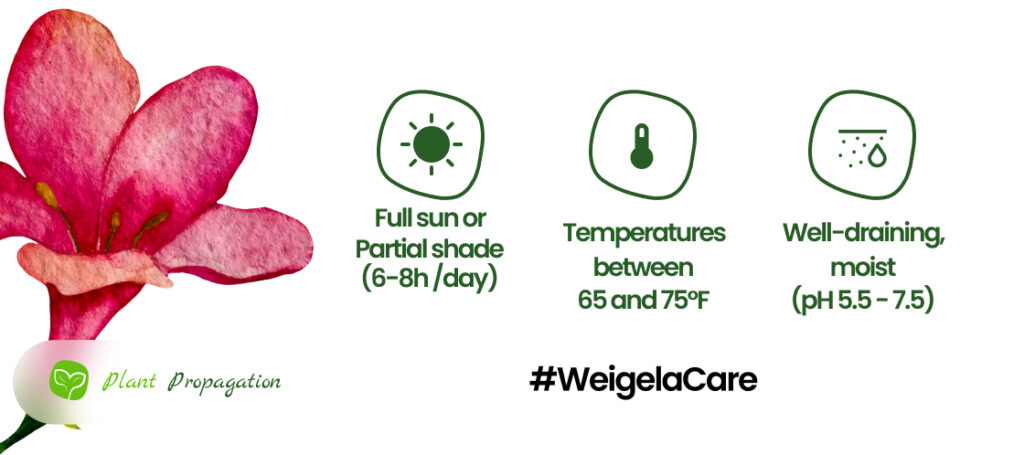
Welcome to the world of trimming Weigela bushes. In this article, we’re going to dive into the ins and outs of pruning Weigela, so you can get those beautiful blooms and perfect shapes you’ve been dreaming of.
Join us as we explore the best times to prune, how often to do it, and the tools you’ll need. From keeping the size in check to giving tired plants a new lease on life, we’ll cover everything you need to know to make your Weigela bushes thrive. So, grab your clippers, and let’s get pruning!
Understanding Weigela
Before we dive into the nitty-gritty of pruning, let’s take a moment to understand our star player: the Weigela shrub. These lovely plants come in various species, with the most common being Weigela florida. Known for their showy flowers that range from delicate pink to vibrant red, Weigela shrubs are a favorite among gardeners looking to add a pop of color to their gardens. Their growth habits vary depending on the variety, but all share a propensity for producing abundant blooms under the right conditions.
When to Prune Weigela
It mostly depends on what kind of Weigela you have and where you live. But as a basic rule, spring is the perfect time to give them a trim, especially right after blooming. This gives them plenty of time for new growth without accidentally cutting off next year’s flowers. If you miss the springtime buzz, don’t worry! You can still do some pruning in late summer or early fall, but you might miss out on some blooms next year.
How Often Should Weigela Be Cut Back
Now that we know when to prune, let’s tackle how often. This mesotonic shrub grows more in width but can reach two meters in height. Generally, you should prune them every two years, however, if your shrub is getting unruly and you need to control its size, you may need to prune it more often. Keep an eye on your Weigela throughout the growing season and prune as needed to keep it looking its best.
Essential Tools for Pruning Weigela
Thankfully, you won’t need a huge arsenal for pruning, but there are some basic tools you’ll need:
- Pruning shears: Perfect for smaller branches and delicate cuts.
- Loppers: Ideal for thicker branches that pruning shears can’t handle.
- Gloves: Protect your hands from thorns and debris.
Before you start cutting (and after you are done with it!), sanitize your tools with a 10% bleach solution. This is one of the best ways to avoid infecting your plant.

Pruning Weigela Step-by-Step
Now, let’s get down to business. Pruning Weigela is really easy, but you need to be clear on what the goal is. Do you want to prune to keep it at a certain size, or do you want to rejuvenate it? Let’s learn both!
Pruning for Controlling Size:
This is how you prune a Weigela shrub to keep it from growing too much:
- Get those tools ready: You can use pruning shears or loppers for trimming Weigelas. Keep in mind that hand pruning results in fuller bushes. Sanitize your pruners before use!
- Trim to shape: Picture how you want your Weigela to look once you’re done pruning. Trim off branches to achieve the desired shape, ensuring not to remove more than one-third of any single branch per season.
- Cut back to where branches meet: When pruning Weigela branches, always cut them back to a point where two branches meet. This encourages healthy growth and maintains the shrub’s natural form.
Pruning for Rejuvenation:
If your Weigela is looking a bit tired, rejuvenation pruning can breathe new life into it. Here’s how to do it:
- Trim withered branches: Start by cutting all withered branches at the base, as close to the ground as possible. Remove any dead branches back to the nearest fork.
- Remove old wood: Since older branches are less likely to flower, it’s best to remove them. Leave behind shoots that are one to five years old and only remove the oldest ones.
- Preserve flowering potential: Since Weigela blooms on perennial shoots in May, avoid radical pruning that could prevent flowering this year.
Aftercare
- Once you’ve finished pruning, give your Weigela a good watering to help it recover from the stress of pruning.
- Apply a layer of mulch around the base of the shrub to help retain moisture and suppress weeds.
- Give it some quality slow-release fertilizer right after pruning.
- Check your Weigela regularly for signs of stress or disease in the weeks following.

Conclusion
Pruning Weigela may seem like a daunting task, but with the right know-how and a little elbow grease, you can keep your shrubs looking their best year after year. The main takeaways are:
- Prune Weigela in spring after blooming to avoid cutting off next year’s flowers.
- Trim every two years, or as needed, to maintain shape and size.
- Have pruning shears and loppers handy for effective trimming.
- Visualize, trim to shape, and cut back to where branches meet for optimal results.
- Remove withered branches and old wood to breathe new life into tired Weigela shrubs.
- Water, mulch, and fertilize after pruning to promote healthy growth.
Frequently Asked Questions
When should weigela be pruned?
You should prune Weigela soon after it finishes blooming in spring. Trim the plant to shape it and control its size, but don’t cut off more than 30% of the top growth. If needed, you can also do some pruning in summer, but make sure to finish before mid-July.
Can you cut weigela back hard?
Older, mature Weigela plants deal well with being cut down to the ground. It encourages fresh growth, but you should mostly time it before winter.
Do weigela need to be cut back in winter?
Weigela doesn’t necessarily need to be cut back in winter. Instead, consider controlling its size by trimming one-third of a branch each season. When pruning, always cut back to where two branches meet, and you can use hand trimmers or hedge clippers for the job.
